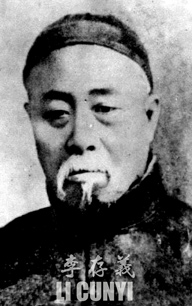Xingyi Quan is an internal style Chinese martial art known for its dynamic and explosive movements. It was descended from Ji Jike and then into two key branches known as Xinyi Liuhe Quan (Heart and Intention six harmonies boxing) and Dai Family Boxing. The Dai family mixed it with other martial arts they practiced and Neigong methods. The founder of Xingyi (Shape and Intention) boxing is Li Nengran, also known as Liu Luoneng.
Li Luoneng was born in Shenzhou City, Hebei Province in 1808; Li passed away in 1890 at the age of 81 years old. He had studied Bafanquan and Tongbeiquan since young and was highly skilled. Li Luoneng resided to Taigu County of Shanxi Province for business purposes at the age of 37 in 1845 and he began to learned Dai family version of Xinyiquan during the same year. Li established himself as a great martial artist in Shanxi, which also earned him the nickname of Divine-Fist-Li (神拳李), within 10 years of after he started in Xinyi.
Li Luoneng began his teaching of his version of Xinyiquan as Xingyiquan at Taigu County in the 1856 until 1871. Che Yizhai (车毅斋, 1833 – 1915), Song Shirong (宋世荣, 1849 – 1927), Song Shide (宋世德, 1857 – 1921), Li Guangheng (李廣亨, 1859 – 1934) are some of his students during this period. This earlier version of Li's Xingyiquan is classified as Shanxi Xingyiquan in modern days Xingyiquan circle.
Li Luoneng, at 63 years old, returned to his hometown, Shenzhou City, in 1871. Li continued to spread the art of Xingyiquan at his hometown in his later years. Guo Yunshen (郭云深, 1820 – 1901), Li Qilan (刘奇兰, 1819 – 1889), Liu Xiaolan (刘晓兰, 1819-1909), He Yunheng (贺运恒) are the students of this period. The Xingyiquan of this period is usually referred as Hebei Xingyiquan.
Hebei Xingyi Quan - Liu Qilan
Liu Qilan (刘奇兰, 1819 – 1889) was one of the top student of Li Luoneng (李洛能). Liu together with Guo Yunshen (郭云深, 1820 – 1901), Song Shirong (宋世荣, 1849 – 1927) and Che Yizhai (车毅斋, 1833 – 1915) are known as the top four disciples of Li Luoneng. Liu Qilan was born in a scholarly family at Shen County, Hebei Province.
Liu Qilan had studied martial arts since his youth, specifically Jingangquan and later learned Xingyiquan from Li Luoneng when Li was invited to teach in Liu family. Liu Qilan was not only skilled with combative techniques but also, with his scholar background, well known with his Xingyiquan theories and concepts; martial artists who have visited Liu were convinced with Liu's martial abilities and theories. The bulk of what is representative of Hebei Xingyi boxing today was developed by Liu Qilan and spread through his descendants. . 
Liu Qilan is known as the principal contributor of Xingyiquan as Liu lineage is the most influential and most widely spread among all other Xingyiquan lineages. Li Cunyi (李存义, 1847 – 1921), Zhang Zhankui (张占魁, 1865 – 1938), Geng Jishan (耿继善), Zhou Mingtai (周明泰), Wang Fuyuan (王福元) and Liu Dianchen (刘殿琛, second son of Liu Qilan) were some of Liu's most well known successors.
Shen County in Hebei province is home to a number of martial arts styles such as Chuojiao, Bafanquan, Xingyiquan and Baguazhang. This resulted in much exchange or practice of numerous styles, this is especially true of Xingyiquan and Baguazhang which were commonly practiced by practitioners. The Cheng village in Shen County which is the home of Cheng Tinghua and later where his younger brother Cheng Dianhua and son, Cheng Youxin would develop their Baguazhang is also known for practicing the Liu Qilan style of Xingyiquan.
BAFANG WUSHU - HEBEI XINGYI QUAN PROGRAM
The Xingyiquan program of Bafang Wushu is predominantly based on the teachings of M. Sun Zhijun as inherited by M. Ge Chunyan.
Cheng Style Bagua Lianhuan Zhuan Zhang (八卦连环转掌 Continuous Turning Palms)
The foundation of Xingyiquan is in standing (Zhuang gong) and San Tishi. This is then followed by stepping practice.
Five Elements (五行拳)
The five phases fists include Chopping (Pi 劈), Crushing (Beng 崩), Zhuan (Drilling 钻), Pao (Explode 炮) and Heng (横) which are correlated to the five phases theory of traditional chinese Daoist cosmology. These being Metal, Water, Wood, Fire and Earth. These are the most important foundation in Xingyiquan, whilst each of the methods apply a number of vectors and thus power generation, they also contain the basis of contraction and expansion, means to the three powers (Ming, An, Hua), the various footwork and the manifestations of the basic methods.
- Five Elements individual practice | 五行拳(劈、崩、钻、炮、横)
- Lianhuan (Continuous) | 五行连环拳
Twelve Animals (十二形拳)
The 12 animals are the heart of Xingyiquan, where the five phases are said to be the intention foundation (Yi), the 12 animals represent the structure or shape (Xing). There are twelve animals represented such as Dragon, Tiger, Monkey, Horse, Chicken, Yao Sparowhawk, Swallow, Snake, Alligator, Ostrich, Eagle & Bear.
- 12 shapes individual practice | 十二形拳 (龙、虎、猴、马、鸡、鹞、燕、蛇、鼍、骀、鹰、熊)
Combined Sets (综合拳)
Zhashichui (mixed strikes) is said to have been developed by Che Yizhai on the basis of the Dai Family Zhashi (which itself was based on Tanglang Quan), with many methods within. Shier Hongchui consists of strikes in succession whilst turning the body (totalling 12) in addition toother techniques.
- Zha Shi Chui | 杂式锤
- Shier Hong Chui | 十二洪捶
In Xingyiquan as a foundation there are Wuxing (five phases) sets for each of the four main weapons. There are other weapon practices as well including:
For further information about current scheduled modules visit the Classes section here or contact us accordingly.

